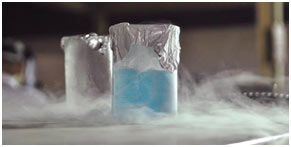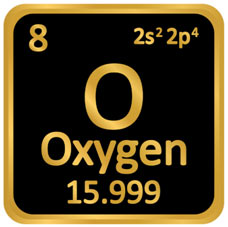Introduction
Oxygen is the 8th element in the periodic table located in group 16 which is known as the chalcogen family.
Oxygen has eight electrons, eight protons, and eight neutrons.
The atomic number of electrons is 8 whereas the atomic mass is 16.
Naming and History of Oxygen
The name oxygen is derived from two Greek words “oxys” and “genes”. It means acid-forming as early scientists thought that oxygen was necessary and the basis of all acids.
The discovery of oxygen is shared by three chemists. In 1608, Cornelis Drebbel first isolated oxygen by heating potassium nitrate. In 1771, Carl Wilhelm Scheele produced oxygen. In 1774, Joseph Priestly made oxygen by focusing sunlight on mercuric oxide and published his observations.
Antoine Lavoisier also claimed the discovery of oxygen and was named by him in 1777.
Occurrence of Oxygen
Oxygen is the essential element of planet Earth and makes about 21% of Earth’s atmosphere and 50% of Earth’s crust. On earth, it comes from photosynthesis a – process by plants. It is fairly soluble in water thus making life possible in aquatic systems.

In binary or bounded form, it exists as water and silica SiO2 most abundantly. Others are calcium oxide, aluminum oxides, oxides of iron and nitrogen, etc.
Properties of oxygen
Oxygen is a highly reactive element and bounds with others to form various compounds. When combined with acetylene it produces a very hot flame which is used for welding purposes.
At room temperature oxygen exists as a gas with a melting point of -218.79°C and a boiling point of -182.95°C. The density of oxygen is 0.001429 grams per cubic centimeter.
Oxygen in biological systems
Photosynthesis uses energy from the sun to split water into oxygen and hydrogen. The oxygen passes into the atmosphere and the hydrogen joins with carbon dioxide to produce biomass. All other living things take in oxygen for respiration and cellular respiration. In aquatic systems, aquatic plants produce oxygen for all life types in water.

Uses of Oxygen
The best commercial use of oxygen gas is in the steel market.
Large amounts are likewise utilized in the manufacture of a wide range of chemicals consisting of nitric acid and hydrogen peroxide.
It is also utilized to make epoxyethane (ethylene oxide), utilized as an anti-freezing agent, and to make polyester, and chloroethene, the precursor to PVC.
When cooled at -183 ℃, oxygen becomes a liquid. Liquid oxygen is used as a propellant for rockets.
Oxygen is used in the mining, production, and manufacture of stone and glass products.
Allotropes of Oxygen
Oxygen is a very reactive component and it does not exist in singular atom form. Oxygen will bond to almost any other element, and if there aren’t any other elements around, it will bond to another oxygen atom. This provides us the allotrope of oxygen.
Dioxygen O2
O2 is the most typical allotrope of oxygen that exists. It is an invisible gas and is just over 20% of the gases in Earth’s atmosphere. The kind of oxygen which we utilized for breathing.
Ozone O3
Ozone is a molecule consisting of 3 bonded oxygen atoms and is slightly blue in color. Depending on where it is in the environment it is either natural or a pollutant. In the atmosphere, it acts as a protective covering and shields the hazardous U.V radiations from reaching Earth. However, in general, as produced by photocopy machines it is a poisonous gas.
Tetraoxygen O4
Tetraoxygen is a crimson solid that is created by pressurizing O2 to the order of 20 GPa. Its properties are being studied for usage in rocket fuels and similar applications.
Metallic Oxygen
When tetraoxygen goes through the pressure of 96 GPa, it ends up being metal, similarly to hydrogen, and becomes more similar to the much heavier chalcogens and shows metallic characteristics.
Isotopes of Oxygen
The component oxygen (O) is present in 3 naturally occurring stable isotopes, O -18, O- 17, and O -16. The nucleus of each of these oxygen isotopes consists of eight protons and either 8, 9, or ten neutrons, respectively. Oxygen-16 is the dominant isotope, comprising more than 99 percent of 100% natural oxygen; oxygen-18 makes up 0.2 percent. Nevertheless, the specific concentration of oxygen-18 in precipitation, particularly at high latitudes, depends on the temperature.
Oxygen isotopes have been used as temperature or environment proxies in a variety of other marine biogenic stages, although far less extensively than in foraminifera or coral reefs.
MCQs
- What is the atomic number of oxygen?
- A) 6
- B) 7
- C) 8
- D) 9
- Answer: C
- What is the primary source of oxygen on Earth?
- A) Volcanic eruptions
- B) Photosynthesis
- C) Ocean currents
- D) Industrial processes
- Answer: B
- Who is credited with the discovery of oxygen?
- A) Antoine Lavoisier
- B) Joseph Priestly
- C) Cornelis Drebbel
- D) Carl Wilhelm Scheele
- Answer: B
- What is the meaning of the name “oxygen” derived from Greek words “oxys” and “genes”?
- A) Fire creator
- B) Acid-forming
- C) Life sustainer
- D) Breath of life
- Answer: B
- What percentage of Earth’s atmosphere does oxygen make up?
- A) 10%
- B) 21%
- C) 50%
- D) 75%
- Answer: B
- At room temperature, in what state does oxygen exist?
- A) Solid
- B) Liquid
- C) Gas
- D) Plasma
- Answer: C
- What is the melting point of oxygen at room temperature?
- A) -218.79°C
- B) -182.95°C
- C) 0°C
- D) 100°C
- Answer: A
- What is the primary commercial use of oxygen gas?
- A) Medicine
- B) Steel industry
- C) Rocket propellant
- D) Food preservation
- Answer: B
- In photosynthesis, what is produced by splitting water into oxygen and hydrogen?
- A) Methane
- B) Oxygen
- C) Carbon dioxide
- D) Biomass
- Answer: B
- What is the common allotrope of oxygen used for breathing?
- A) Dioxygen (O2)
- B) Ozone (O3)
- C) Tetraoxygen (O4)
- D) Metallic Oxygen
- Answer: A
- Which allotrope of oxygen acts as a protective covering in the atmosphere against harmful UV radiations?
- A) Dioxygen (O2)
- B) Ozone (O3)
- C) Tetraoxygen (O4)
- D) Metallic Oxygen
- Answer: B
- What is the color of ozone (O3) when it is in the atmosphere?
- A) Red
- B) Blue
- C) Green
- D) Yellow
- Answer: B
- Under high pressure, what happens to tetraoxygen (O4)?
- A) It becomes a liquid
- B) It turns metallic
- C) It evaporates
- D) It becomes a gas
- Answer: B
- How is metallic oxygen formed?
- A) Under low pressure
- B) Under high pressure
- C) Under high temperature
- D) Under low temperature
- Answer: B
- How many naturally occurring stable isotopes does oxygen have?
- A) 1
- B) 2
- C) 3
- D) 4
- Answer: C
- Which isotope of oxygen is the dominant one in nature?
- A) O-16
- B) O-17
- C) O-18
- D) O-19
- Answer: A
- What role do oxygen isotopes play as proxies in marine biogenic stages?
- A) Temperature indicators
- B) Oxygen producers
- C) pH level regulators
- D) Carbon dioxide absorbers
- Answer: A
- What is the density of oxygen at room temperature?
- A) 0.0001 grams per cubic centimeter
- B) 0.001 grams per cubic centimeter
- C) 0.01 grams per cubic centimeter
- D) 1.0 grams per cubic centimeter
- Answer: B
- What does oxygen bond with to produce a very hot flame used in welding?
- A) Nitrogen
- B) Acetylene
- C) Hydrogen
- D) Helium
- Answer: B
- In what form is oxygen commonly used as a propellant for rockets?
- A) Gas
- B) Liquid
- C) Solid
- D) Plasma
- Answer: B
- Which scientist claimed the discovery of oxygen and named it in 1777?
- A) Antoine Lavoisier
- B) Joseph Priestly
- C) Cornelis Drebbel
- D) Carl Wilhelm Scheele
- Answer: A
Summary
In conclusion, this comprehensive tutorial on oxygen covered various aspects, including its occurrence, properties, allotropes, isotopes, and uses.
- Oxygen Overview:
- Oxygen, the 8th element in the periodic table, is a vital component of the chalcogen family in group 16. With eight electrons, protons, and neutrons, its atomic number is 8, and the atomic mass is 16.
- Naming and History:
- The naming and history of oxygen trace back to the Greek words “oxys” and “genes,” meaning acid-forming, reflecting the early belief that oxygen was fundamental to all acids. Discovered by multiple chemists, including Cornelis Drebbel, Carl Wilhelm Scheele, and Joseph Priestly, Antoine Lavoisier officially named oxygen in 1777.
- Occurrence:
- Oxygen’s occurrence on Earth is extensive, constituting approximately 21% of the atmosphere and 50% of the crust. Primarily produced through photosynthesis by plants, it plays a crucial role in aquatic systems and exists in various forms like water and silica SiO2.
- Properties:
- Being a highly reactive element, oxygen forms compounds, and its properties include a gaseous state at room temperature, with a melting point of -218.79°C and a boiling point of -182.95°C. Its density is 0.001429 grams per cubic centimeter.
- Biological Systems:
- Oxygen’s role in biological systems involves photosynthesis, where it is produced from the splitting of water, contributing to the atmosphere, and aiding in the formation of biomass.
- Uses:
- Commercially, oxygen finds extensive use in the steel industry and chemical manufacturing. It is utilized in diverse applications such as the production of nitric acid, hydrogen peroxide, epoxyethane, and polyester. Liquid oxygen serves as a rocket propellant, and oxygen is essential in mining, stone production, and glass manufacturing.
- Allotropes:
- The tutorial explores the allotropes of oxygen, including dioxygen (O2), ozone (O3), tetraoxygen (O4), and metallic oxygen. Dioxygen, the most common allotrope, constitutes over 20% of Earth’s atmosphere and is crucial for breathing. Ozone acts as a protective layer in the atmosphere, shielding against harmful UV radiations. Tetraoxygen, under high pressure, exhibits unique properties, and metallic oxygen emerges under specific conditions, resembling heavier chalcogens.
- Isotopes:
- Oxygen isotopes, including O-18, O-17, and O-16, play a role as temperature or environment proxies, with O-16 being the dominant isotope. Their concentration in precipitation, particularly at high latitudes, depends on temperature variations.
In summary, this tutorial provides a comprehensive understanding of oxygen’s significance in nature, industry, and biological processes, encompassing its diverse properties and applications.

